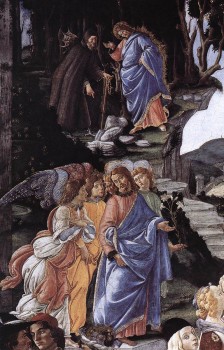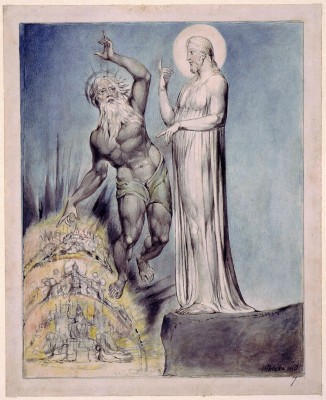 There are so very many ways to get lost. And most of them include some kind of stumbling over love. Even Jesus had to wrestle with what it meant to be loved, and he had to do it more than once.
There are so very many ways to get lost. And most of them include some kind of stumbling over love. Even Jesus had to wrestle with what it meant to be loved, and he had to do it more than once.
When the name Beloved washed over him at the Jordan, he didn’t get to bask safely in the gleaming medallion of it. Matthew tells us (and Luke agrees) he was immediately driven into the wilderness, alone and beset by powerful temptations. According to Webster, temptation is the enticing, alluring desire to do something unwise. And so it was, for Jesus.
Power. Fulfillment. And the freedom to go it alone. These were the temptations that came to Jesus, and it took him days, so many days, weeks of days, to rise above them. Wrestling with temptation seems to be an essential part of the human journey. And for many of us, the struggle lasts for years. And for some, the fall is profound; even into death.
Philip Seymour Hoffman fell into death, succumbing to the enticing siren song of desire to complete his Belovedness alone. The sorrowing ache in him, that plagued him for years and years, was there in every on screen performance, part of him and part of every character he played. We were awed by his ability to present this dimension of our human condition. 
This year, perhaps more than any other, many of the movies in contention for Best Film illustrate powerful temptations. The Wolf of Wall Street, based on a biography and seeming to illustrate several recent exposes of firms, is a tour-de-force presentation of the temptation of money. Jonah Hill, nominated for Best Supporting Actor, says he wanted the role because he knew men he had grown up with who worshipped wealth that exclusively, who could not see anything in life as alluring, as enticing, as money. Leonard DiCaprio’s character, Jordan Belfort, who wrote the book, danced to all the tunes the Devil called: drugs, sex, financial corruption; for the wealth he so desired.
Blue Jasmine may win Cate Blanchette an Oscar for her performance as a woman who has sacrificed everything she had for a wealthy lifestyle, living happily among people who, like her, had no other real attachments, until ill fortune plunges her into the misery of blue collar life, from which she tries to escape by going it alone, and fails.
American Hustle seems to preach the sermon on greed for power New Jersey Gov. Chris Christie’s troubled regime needed to hear. 
Philomena, Nebraska , and Dallas Buyers Club, turn the camera toward the meek and the persecuted, showing the suffering that is brought to them by the greed and cruelty of the powerful around them, who have become slaves to their own temptations. The young Philomena is persecuted by nuns who sell babies for money and who enjoy lording it over penniless pregnant young women, cudgeling them with cruel words and heaping shame abusively upon them. Nebraska shows the wonder of a family that never had much love for one another, rediscovering their dignity, honor, and abiding affection, by remembering the temptations they have managed to decline and declining the temptation to pull apart from each other again. Dallas Buyers Club follows a dissolute, homophobic, hate-filled blue collar Texan through his discovery that he has AIDS, into his creation of a group of mostly gay men who buy effective drugs from other countries and smuggle them in to keep themselves alive.
Perhaps it is hard to see Jesus in any of these situations, but each of them was a lengthy wilderness experience, each required a huge struggle for self-definition, and each required learning how to embrace the name Beloved, and how to discover what it really meant.
Perhaps the most biblical of this year’s films is 12 Years A Slave, in which the culturally embedded southern temptation to self-identify as holy slave masters becomes a devilish mask for horror, shown to us through the unflinching eyes of Solomon Northup, who hangs on fiercely to his own Belovedness as the identity he will not relinquish in the wilderness of his twelve pre-Civil War years as a slave.
 Worship Me! cries the Devil to each of us, and at oh-so-opportune times. And we do need these stories, each showing us another way in which temptation ensnares us with its siren songs, and how the clay feet of our false idols do emerge at last. And there is no place at all that cannot become a wilderness, family life, the car pool, small towns, large cities, the church, even a zealous vision – false idols are everywhere.
Worship Me! cries the Devil to each of us, and at oh-so-opportune times. And we do need these stories, each showing us another way in which temptation ensnares us with its siren songs, and how the clay feet of our false idols do emerge at last. And there is no place at all that cannot become a wilderness, family life, the car pool, small towns, large cities, the church, even a zealous vision – false idols are everywhere.
Trailing his wonderful name behind him, sprinkling drops of it on all of us, Jesus wends his way through thickets of conversation, angry mobs, stumbling friends, till he comes to the brooding city, as tense as Kiev is today. The shadows lengthen, and he wrestles with his fearful temptations in the Garden. We know how the story ends. And how it can be written for us.
And how God’s Love is both a fearful and a wonderful thing. ________________________________________________________________ Illustrations:
1. Temptation of Christ, by Sandro Botticelli, 1478, Capella Sistina, Vatican City. Note, the Devil (at top of painting) wears clerical garb and holds a rosary. Vanderbilt Divinity School Library, Art in the Christian Tradition.
2. The Second Temptation, by William Blake, 1816, illustration from Paradise Regained. Vanderbilt Divinity School Library, Art in the Christian Tradition.
3. Jesus Carried Up to a Pinnacle of the Temple, by James Jacques Joseph Tissot, 1887, Brooklyn Museum, New York. Vanderbilt Divinity School Library, Art in the Christian Tradition.
4. Jesus and the Tempter, by Juan de Flandes, 1500, National Gallery of Art, Washington, D.C. Vanderbilt Divinity School Library, Art in the Christian Tradition.











